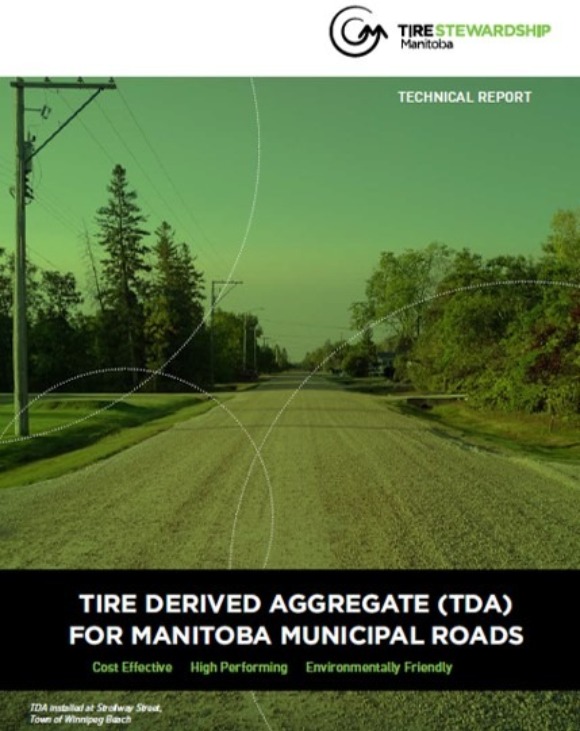Manitoba program continues to
develop TDA solutions ...
Tire Derived Aggregate (TDA) has been used in civil engineering projects, mainly as a construction material, for almost thirty years. Given its unique properties such as durability, flexibility and light weight, the variety of its applications has seen significant growth over that time.
For many years, Tire Stewardship Manitoba (TSM) has supported TDA as a viable and sustainable solution for the scrap tires generated in Manitoba. Currently representing about 75% of the final markets for end-of-life tires processed in the province, from an environmental perspective TDA offers a high-volume, cost-effective option. One cubic meter of TDA fill consumes about 100 chipped or shredded tires and depending on the project scope, can require anywhere from 20,000 to a million tires or more.
TDA is typically used to replace other more traditional materials (soil, gravel, clean fill, and lightweight fill such as polystyrene) and offers an economical solution for projects that would benefit from its unique attributes. The broad categories of civil engineering applications for TDA are: Road Construction (embankments, stabilization, retaining walls, edge drainage, road sub-grade, thermal insulation for frost reduction); Septic Construction (absorption trenches); Light-Rail Construction (vibration abatement); Landfill Construction (drainage layer, leachate or gas collection, cover material); and Building Foundations (backfill/drainage).
In recent years, TSM has focused primarily on TDA used in road construction and building foundations:
- From 2008 when the province’s program transitioned from a government-run to a stewardship model, TSM continued to support the use of Manitoba TDA in municipal road construction and repair, offering a light-weight fill material to improve the stability of embankments built on weak soils in rural roads.
TSM’s technical report (May 2018) “Tire Derived Aggregate (TDA) for Manitoba Municipal Roads” identifies the road projects completed and highlights the features and costs of TDA compared to natural aggregate.
- In 2017, TSM awarded an applied research grant to Red River College to test TDA made from passenger/light truck and medium truck tires as a replacement for natural material in basement backfill applications. It followed an earlier TSM grant to the college to create an Experimental House on campus to install and test, in Manitoba’s climes, the technical and commercial viability of TDA from off-the-road tires as backfill under concrete slab floors and outside concrete basement walls.
The final report (June 2018) “Demonstration of the Viability of Using Tire Derived Aggregate (TDA) to Replace Natural Material (NM) in Residential Home Basement” details the specifications and results of this multi-year initiative. With no negative effects identified, the comparative outcomes of TDA were positive in the key areas of heat loss, moisture retention and lateral pressure on basement walls.
“(…) the work we did was very thorough and methodical. It (TDA) is a viable product and can be used effectively” said researcher and report author Shokry Rashwan, Ph.D., P.Eng., Paul Charette-Manitoba Applied Research Chair in Sustainable Construction.
TSM previously also supported a University of Manitoba project using TDA in a rural residential septic system application, and an Honours Thesis assessing the use of TDA in a constructed wetland filtration system of a municipal wastewater lagoon.
When it comes to using TDA, Shokry Rashwan stresses the importance of ensuring that the required standards are met, a lesson learned early on in the TSM backfill study. “Unless the product is made properly with the correct specifications, the results will fluctuate significantly. The installation is critical to positive performance – the notion that you can just dump it (TDA) in is wrong.”
Want more information?
Visit TSM’s website for further studies and reports supported by the Manitoba agency.
For information on other Canadian tire recycling programs and their end markets from processing end-of-life tires, follow the links on the CATRA website.
